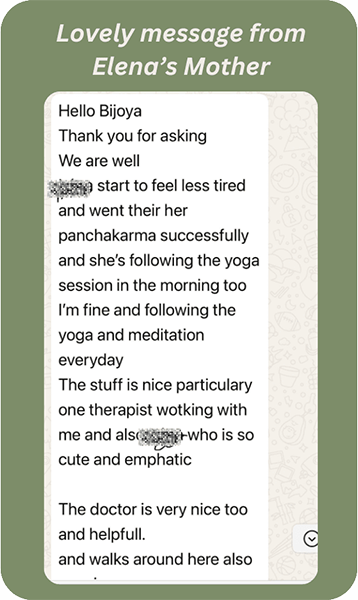Ayurvedic Happy Hormones: Supporting Children’s Mental Health Naturally
Ayurvedic Happy Hormones: Supporting Children’s Mental Health Naturally

In a world that spins faster each day, where achievement often takes priority over emotional harmony, we are quietly witnessing an unfolding crisis. This crisis touches the most tender hearts among us—the mental health of our children. Emotional outbursts, social withdrawal, chronic fatigue, anxiety, and attention struggles are no longer rare occurrences. They are becoming familiar signs, even among the youngest souls in our homes and classrooms.
As we honor this month of Children’s Mental Health Awareness, we invite you to pause. Not with fear, but with hope. Because there is another way. A path that honors childhood, nurtures emotions, and speaks to the body and mind through ancient, deeply rooted wisdom. That way is Ayurveda for kids.
When Joy Becomes Elusive: The Unspoken Weight Our Children Carry
It often begins with subtle signs. A child who once sang through the hallways now prefers silence. A curious mind begins dreading school. A once joyful child grows irritable, complains of stomach pain, or seems constantly tired. Despite our best efforts—consulting therapists, nutritionists, or doctors—the inner turmoil continues.
Perhaps what they are experiencing cannot be resolved only through conventional tools. Perhaps the imbalance lies in the silent intersection where overstimulation, emotional loneliness, food habits, environmental overwhelm, and inner constitution coexist.
Parents whisper in concern:
“My child doesn’t seem like themselves anymore.”
“Everything we try just doesn’t help.”
“It’s like something deeper is wrong, but we can’t find it.”
Before we offer solutions, we must gently ask: Can we recognize the signs?
Recognizing When a Child’s Mental Health Is Calling for Help
Children rarely use words to describe inner distress. Their language is behavior, their tone is energy. These are signs that may point to emotional imbalance:
- Changes in appetite or sleep patterns
- Frequent complaints of stomach aches or headaches with no medical cause
- Avoidance of social situations or previously enjoyed activities
- Sudden bursts of anger or prolonged irritability
- Difficulty concentrating or completing tasks
- Excessive fears or unexplained sadness
Acknowledging these signs is not an admission of failure. It is a powerful first step toward understanding and healing.
This article is a heartful offering to those voices. It is for every parent who stays awake in quiet worry. For every teacher who sees a student’s sparkle dim. For every caregiver who longs to hear the full sound of a child’s laughter again. It is a soft but steady reminder that there is a gentle, profound way to help. A way rooted in nature, compassion, and timeless understanding.
Ayurveda: A Science That Sees the Whole Child
Ayurveda, the ancient science of life that emerged over 5,000 years ago, offers more than a method for treating disease. It invites us to see the wholeness of each being—body, mind, emotions, and spirit. This includes children, in all their wonder and sensitivity.
In Ayurveda, children are not considered miniature adults. They are radiant beings in a delicate phase of development, shaped by their unique body constitution. Their emotions shift easily, and their bodies absorb the rhythms of the environment. Ayurveda honors this complexity, offering gentle yet powerful ways to support emotional well-being in children, restore their happy hormones, and protect their innate joy.
How Today’s World Disrupts Our Children’s Mental Harmony
Modern childhood unfolds in environments that quietly stress the nervous system and unsettle emotional stability. Consider what many children now face each day:
- Constant exposure to screens that interfere with sleep and mood regulation
- Processed foods that destabilize digestion and emotional balance
- High-pressure academic and social demands that replace joy with anxiety
- Urban noise and sensory overload that confuse and fatigue young minds
These experiences slowly unravel a child’s inner resilience. Over time, many children develop anxiety, poor concentration, immune weakness, and low mood. Therapy and psychological care are essential tools. Yet there is another, complementary approach—a daily system of natural stress relief for kids that supports their entire being.
How Ayurveda Gently Rebuilds Resilience and Joy
Ayurveda does not chase symptoms. It nourishes the root. Its practices are quiet but profound, rebuilding the soil of well-being so that children can blossom naturally.
Creating Daily Rhythms That Ground and Soothe
Ayurveda’s dinacharya, or daily routine, becomes a protective rhythm for children when practiced with gentleness. This rhythm tells the nervous system, “You are safe.”
- Regular mealtimes and bedtimes aligned with the body’s natural cycles
- Gentle, warm oil massage (abhyanga) to soothe restlessness and improve sleep
- Quiet, tech-free rituals that foster presence and mindfulness for children
Healing Foods That Nourish the Mind and Gut
Ayurveda teaches that digestion is the foundation of both physical and mental wellness. In children, the gut-brain connection is especially strong. Imbalances in digestion can manifest as irritability, anxiety, and poor concentration.
Warm, freshly prepared meals rich in digestion-friendly herbs like fennel, cumin, and turmeric support mood and brain health. Simple meals with ghee, cooked fruits, and soft grains bring both comfort and nourishment. These choices naturally stimulate the production of serotonin and other happy hormones Ayurveda recognizes as vital to well-being.
Herbal Support for Emotional Balance
Some Ayurvedic herbs for children’s health offer emotional support when chosen carefully. Herbs such as Brahmi, Shankhpushpi, and Ashwagandha (used mindfully and with expert guidance) can ease anxiety, support learning, and improve sleep. These are not medications, but gentle allies that promote harmony in a child’s growing mind.
Breath and Sound as Healing Anchors
Children affected by Vata imbalance may become restless, anxious, or fearful. Simple practices involving breath and sound can restore calm. Soft guided breathing, humming, and exposure to peaceful mantras help children anchor their emotions and return to a state of ease.
Ayurveda Is Not an Alternative. It Is an Ally.
Ayurveda is not here to replace medical care. It is here to walk beside it. This path of Ayurvedic parenting is not about choosing one way over another. It is about embracing a holistic child wellness approach that integrates physical, emotional, and mental support.
It gently supports:
- Healthy sleep and digestion
- Reduction of stress hormones like cortisol
- Increased focus and mental clarity
- Emotional regulation through loving routine and natural nourishment
This is not about controlling behavior. It is about understanding the emotional language of the child and responding with care.
A Gentle Wake-Up Call for Parents, Teachers, and Caregivers
Our children are absorbing the hurried, overstimulated energy of the world around them. Their sensitive systems are silently calling for support. And we can answer.
We can choose calm over chaos. We can create moments of warmth and rhythm that help them feel secure. We can offer tools that respect their emotional depth. We can bring back the joy that is their birthright.
Ayurveda offers us not only practices, but a philosophy. A way of living that helps children not just survive, but truly thrive.
This is our invitation.
Connect with ASHAexperience
If you are a parent, an educator, or a wellness guide seeking answers that embrace the fullness of a child’s emotional and physical journey, we warmly welcome you to connect with us.
Our global team of Ayurvedic doctors and wellness therapists is here to listen, support, and walk beside you. With deep reverence for the inner world of children and the ancient science of Ayurveda, we are here to co-create a space where healing can begin.
Let us together nurture kids’ mental resilience not through pressure, but through presence. Let us create a world where joy is protected, emotions are honored, and childhood is cherished.
To begin your journey, you are welcome to explore our personalized Ayurvedic support for children and families. We are here, gently waiting, whenever you are ready.
We believe in collaborative relationship-based care where our Ayurvedic Doctors, Ayurvedic Practitioner, Ayurvedic Supplement Brands, Ayurvedic Nutritionists & Chefs, Yoga, and Meditation Trainers are in sync. Contact the team who passionately works together to hold your hand in this healing journey.






